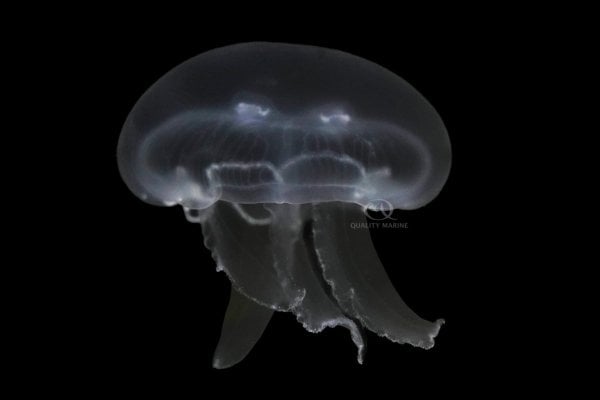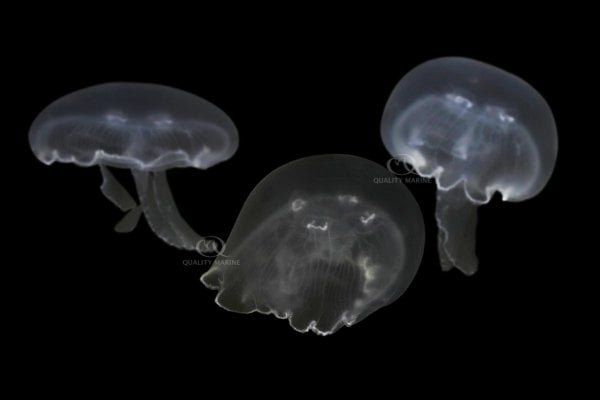Aurelia aurita is the scientific name (or binomial nomenclature) for one of the world's most common (and beautiful) jellyfish. They are called a few different things, among them “Moon Jelly” is probably the most common, though “Common Jellyfish” and “White Jellyfish” are also sometimes used. In France, they are usually referred to as “Méduse commune” which we also like.

Next up in husbandry is how to feed Aurelia aurita (or most other jellies). Moon Jellies feed by immobilizing small prey by utilizing stinging cells called nematocysts. These are located in the four “oral arms” that also help move this prey to the gastric pouches, which have multiple uses for jellies, but for the conversation of feeding, can be thought of as a stomach. The pulsating cilia around the bell of the jelly are also used to help push food toward these oral arms. Luckily for us as aquarists, these arms and cells won't differentiate live food from quality thawed foods, and so these foods just need to be meaty in nature, preferably high in fat and sized correctly for your Jellies to eat. In the wild, they will eat plankton, copepods, small shrimp and fish, so some really great and easily available foods for them in captivity would be things like Gamma Mysis, Gamma Brine Shrimp plus Omega 3s, Gamma Brine Shrimp plus Spirulina, Gamma Rotifers and Gamma Copepods; bigger specimens will also take Gamma Krill, Gamma Chopped Mussel, and even Silversides that are chopped small enough. Start feeding small amounts at a time, while tracking how much you are feeding. One nice thing about feeding jellies is that they are clear, and you can see when they are full! They should be fed at least once a day. Nutramar live brine shrimp and their nauplii (baby brine) are good foods for Jellies, feeding these brine shrimp well will help their nutritional profile. Click here to learn more about Moon Jellies


Next up in husbandry is how to feed Aurelia aurita (or most other jellies). Moon Jellies feed by immobilizing small prey by utilizing stinging cells called nematocysts. These are located in the four “oral arms” that also help move this prey to the gastric pouches, which have multiple uses for jellies, but for the conversation of feeding, can be thought of as a stomach. The pulsating cilia around the bell of the jelly are also used to help push food toward these oral arms. Luckily for us as aquarists, these arms and cells won't differentiate live food from quality thawed foods, and so these foods just need to be meaty in nature, preferably high in fat and sized correctly for your Jellies to eat. In the wild, they will eat plankton, copepods, small shrimp and fish, so some really great and easily available foods for them in captivity would be things like Gamma Mysis, Gamma Brine Shrimp plus Omega 3s, Gamma Brine Shrimp plus Spirulina, Gamma Rotifers and Gamma Copepods; bigger specimens will also take Gamma Krill, Gamma Chopped Mussel, and even Silversides that are chopped small enough. Start feeding small amounts at a time, while tracking how much you are feeding. One nice thing about feeding jellies is that they are clear, and you can see when they are full! They should be fed at least once a day. Nutramar live brine shrimp and their nauplii (baby brine) are good foods for Jellies, feeding these brine shrimp well will help their nutritional profile. Click here to learn more about Moon Jellies












